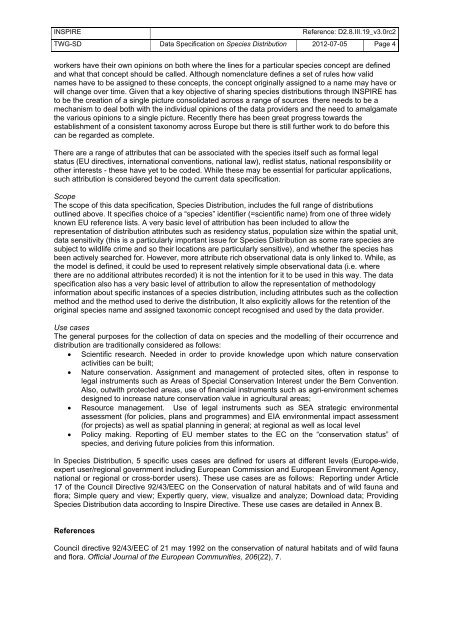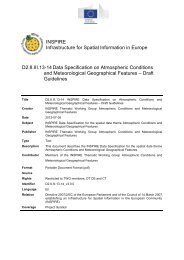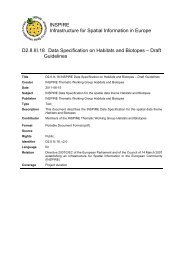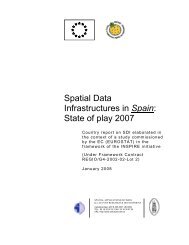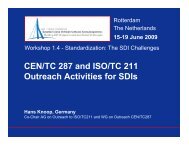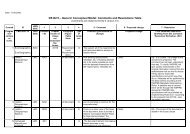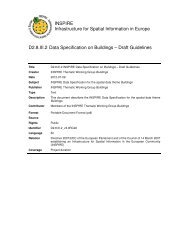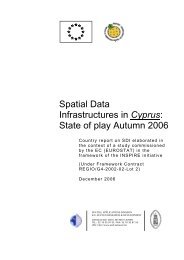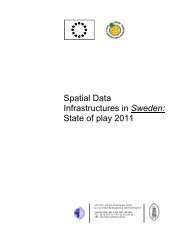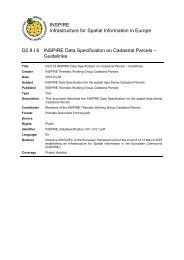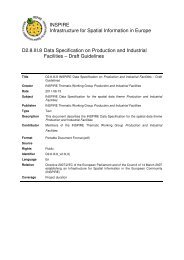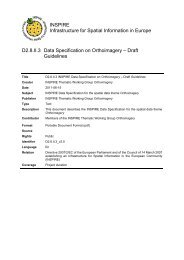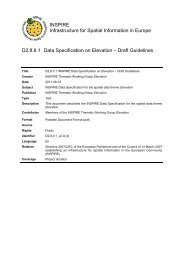Download Version 3.0 rc2 - Inspire - Europa
Download Version 3.0 rc2 - Inspire - Europa
Download Version 3.0 rc2 - Inspire - Europa
Create successful ePaper yourself
Turn your PDF publications into a flip-book with our unique Google optimized e-Paper software.
INSPIRE Reference: D2.8.III.19_v<strong>3.0</strong><strong>rc2</strong><br />
TWG-SD Data Specification on Species Distribution 2012-07-05 Page 4<br />
workers have their own opinions on both where the lines for a particular species concept are defined<br />
and what that concept should be called. Although nomenclature defines a set of rules how valid<br />
names have to be assigned to these concepts, the concept originally assigned to a name may have or<br />
will change over time. Given that a key objective of sharing species distributions through INSPIRE has<br />
to be the creation of a single picture consolidated across a range of sources there needs to be a<br />
mechanism to deal both with the individual opinions of the data providers and the need to amalgamate<br />
the various opinions to a single picture. Recently there has been great progress towards the<br />
establishment of a consistent taxonomy across Europe but there is still further work to do before this<br />
can be regarded as complete.<br />
There are a range of attributes that can be associated with the species itself such as formal legal<br />
status (EU directives, international conventions, national law), redlist status, national responsibility or<br />
other interests - these have yet to be coded. While these may be essential for particular applications,<br />
such attribution is considered beyond the current data specification.<br />
Scope<br />
The scope of this data specification, Species Distribution, includes the full range of distributions<br />
outlined above. It specifies choice of a “species” identifier (=scientific name) from one of three widely<br />
known EU reference lists. A very basic level of attribution has been included to allow the<br />
representation of distribution attributes such as residency status, population size within the spatial unit,<br />
data sensitivity (this is a particularly important issue for Species Distribution as some rare species are<br />
subject to wildlife crime and so their locations are particularly sensitive), and whether the species has<br />
been actively searched for. However, more attribute rich observational data is only linked to. While, as<br />
the model is defined, it could be used to represent relatively simple observational data (i.e. where<br />
there are no additional attributes recorded) it is not the intention for it to be used in this way. The data<br />
specification also has a very basic level of attribution to allow the representation of methodology<br />
information about specific instances of a species distribution, including attributes such as the collection<br />
method and the method used to derive the distribution, It also explicitly allows for the retention of the<br />
original species name and assigned taxonomic concept recognised and used by the data provider.<br />
Use cases<br />
The general purposes for the collection of data on species and the modelling of their occurrence and<br />
distribution are traditionally considered as follows:<br />
• Scientific research. Needed in order to provide knowledge upon which nature conservation<br />
activities can be built;<br />
• Nature conservation. Assignment and management of protected sites, often in response to<br />
legal instruments such as Areas of Special Conservation Interest under the Bern Convention.<br />
Also, outwith protected areas, use of financial instruments such as agri-environment schemes<br />
designed to increase nature conservation value in agricultural areas;<br />
• Resource management. Use of legal instruments such as SEA strategic environmental<br />
assessment (for policies, plans and programmes) and EIA environmental impact assessment<br />
(for projects) as well as spatial planning in general; at regional as well as local level<br />
• Policy making. Reporting of EU member states to the EC on the “conservation status” of<br />
species, and deriving future policies from this information.<br />
In Species Distribution, 5 specific uses cases are defined for users at different levels (Europe-wide,<br />
expert user/regional government including European Commission and European Environment Agency,<br />
national or regional or cross-border users). These use cases are as follows: Reporting under Article<br />
17 of the Council Directive 92/43/EEC on the Conservation of natural habitats and of wild fauna and<br />
flora; Simple query and view; Expertly query, view, visualize and analyze; <strong>Download</strong> data; Providing<br />
Species Distribution data according to <strong>Inspire</strong> Directive. These use cases are detailed in Annex B.<br />
References<br />
Council directive 92/43/EEC of 21 may 1992 on the conservation of natural habitats and of wild fauna<br />
and flora. Official Journal of the European Communities, 206(22), 7.


